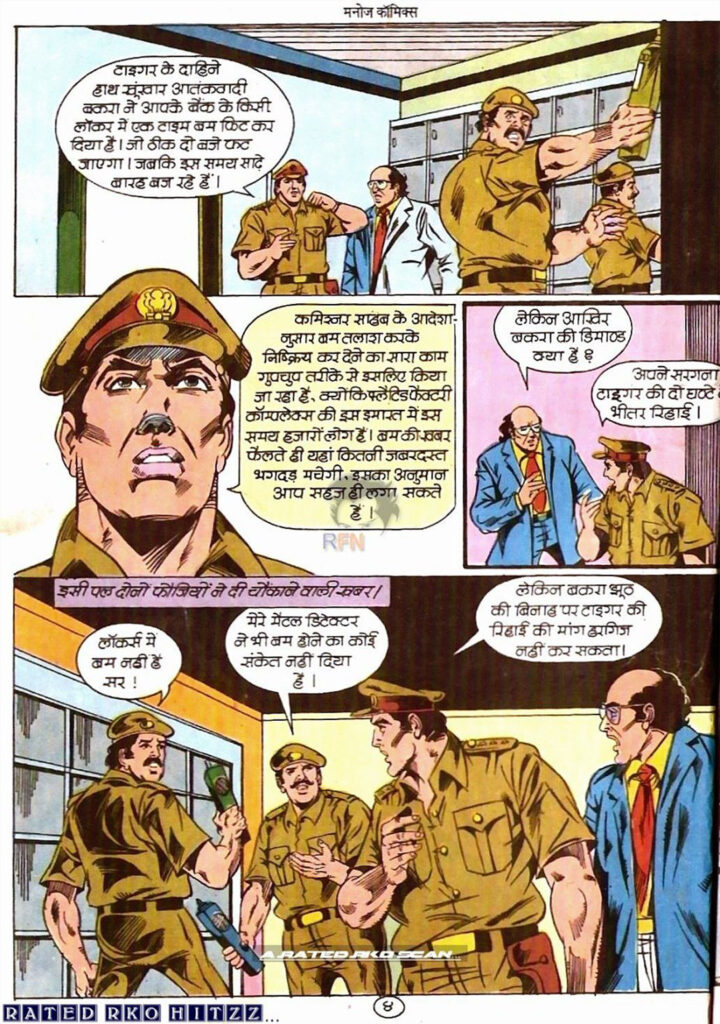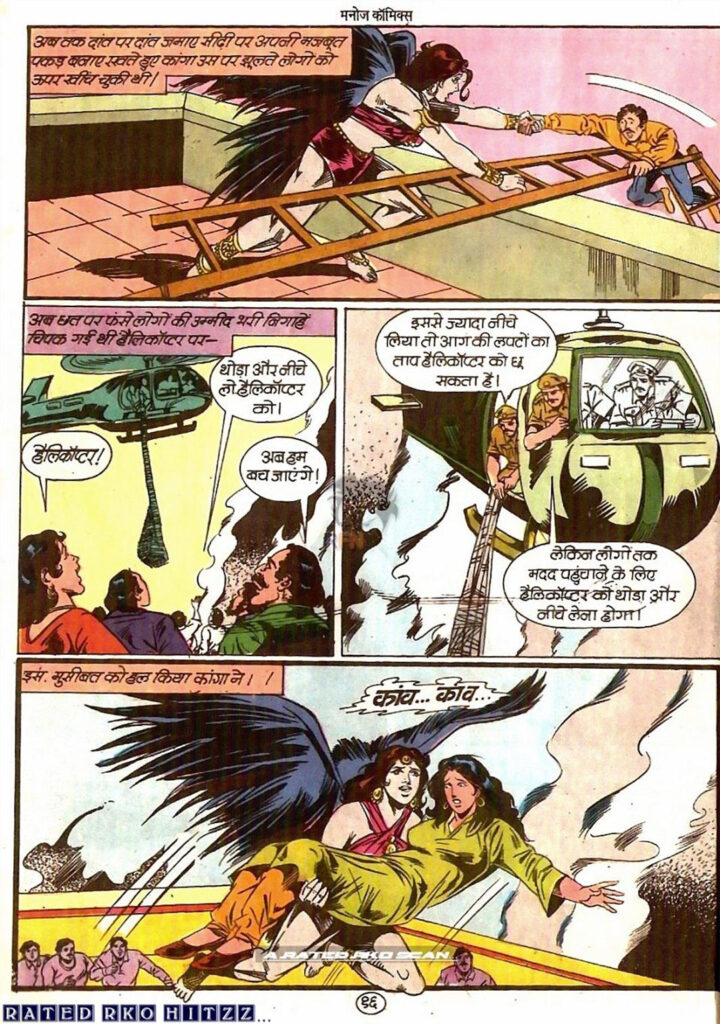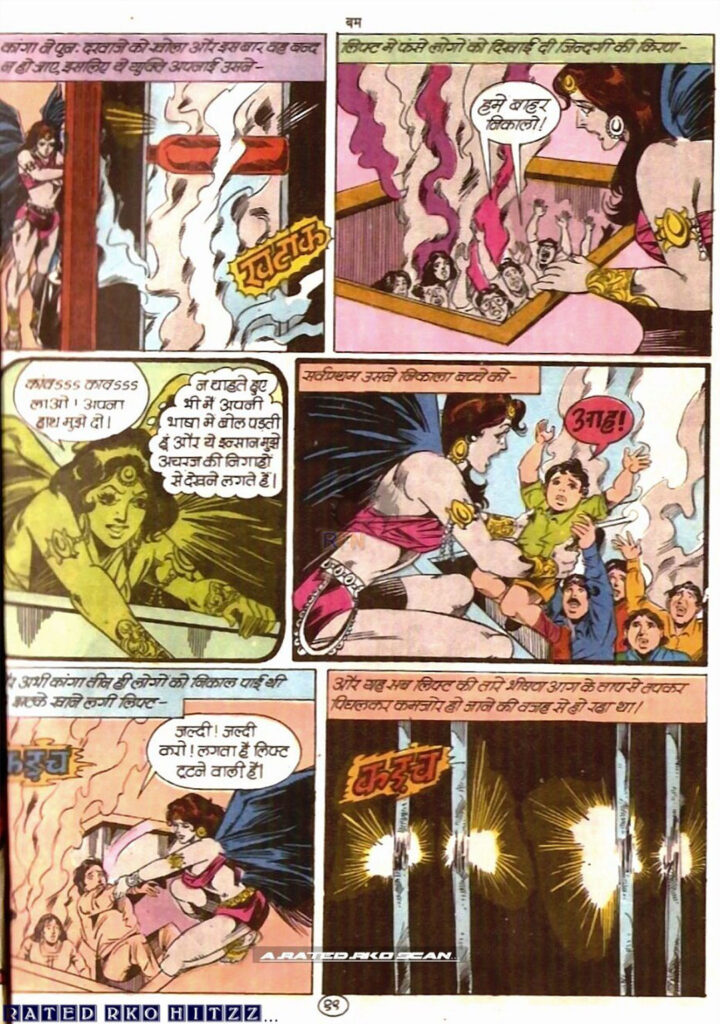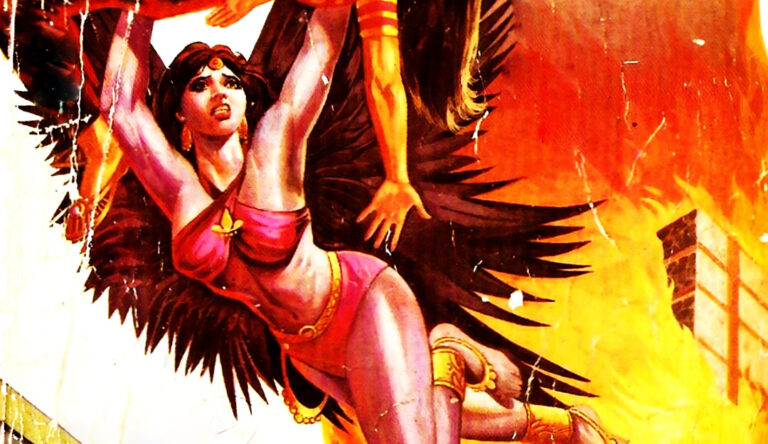In the golden era of Indian comics, Manoj Comics had created a unique identity for itself. Its special issues often brought something new and exciting for the readers. In the same line, issue number 99, priced at Rs. 16.00, presents the story Bum (Bomb). This comic isn’t just a simple superhero saga; it’s an unmatched blend of a high-octane disaster thriller, a terrorist conspiracy, and a supernatural mystery. The credit for Barudi Lekhan has been given to Tilak, Golidar Edit to Sandeep Gupta, and Chitrakran to Kadam Studio. This special issue will be remembered for its rapid pace, tense atmosphere, and a highly unexpected (and somewhat confusing) ending.
The essence of the plot: The countdown to mayhem
The story begins with a very tense scene. A man (who we later know as Inspector Speed) is trapped in a red car. He has only half an hour left before a bomb explodes. His goal is to save the Crow Girl (Kanga), but his car is surrounded by a dreaded pack of hungry hounds, who are ready to tear it apart as soon as he steps out. He helplessly thinks, “What should I do?”
The scene sets itself in the readers’ minds like a puzzle, and then the story moves into a flashback (or main plot).
Part 1: Bomb Panic
Police vehicles and fire engines suddenly start arriving in front of an 18-storey flatted factory complex building in the city. A team of police led by Inspector Speed arrives directly at the Bank of Millionaires (Bank of Crorepati), located on the 18th floor. Once there, the bank is immediately evacuated of customers and employees, causing confusion and panic among the people.

When the bank’s manager, Mr. Adhikari, asks Inspector Speed the reason, a sinister conspiracy is revealed. Speed explains that after the arrest of Tiger, the leader of the terrorist group Handgrenade (Hand Grenade), his right-hand man, the dreaded terrorist Bakra, has planted a time bomb in one of the bank’s lockers.
The tension meter rises further when Speed says that the bomb is going to explode at exactly two o’clock, and at this time, the clock shows 12:30. They have only one and a half hours left. Bakra demands that Tiger be released within two hours. The entire operation has been kept secret because there are thousands of people in the building, and as soon as the news of the bomb spreads, a terrible stampede could occur.
Part 2: Failed Discovery and Impending Disaster
Speed’s team, consisting of Mr. Swami and Mr. Thackeray, starts searching 2,000 lockers with a Metal Detector (not Mattel Detector). But within a short time, they report that the detectors have not found any sign of a bomb. The manager argues that Bakra cannot make demands based on lies, but Speed is convinced that the bomb is there. He says, “Plants can deceive once, but dogs cannot.”
He immediately makes a call to headquarters, ordering them to call sniffer dogs. The delay in the dogs’ arrival wastes precious time; Speed angrily says, “The whole hour and a half has been wasted!” (Although the timing seems a bit inconsistent in the story, it effectively reflects the stress.) Trained dogs rapidly start sniffing each locker.

The hands of the clock are running fast. When only five minutes remain until the bomb explodes, a dog begins scraping Locker No. 100 with its claws. Speed yells, “Got it! Got the locker with the bomb!” They now have just three minutes. Mr. Swami tries to drill the locker but hastily breaks the bit of the drill (the drill breaks!). Now only fifty seconds are left. Speed understands that it is now impossible (useless) to defuse the bomb. Nothing can be done now.
He immediately orders the floor to be vacated, but the people outside are unwilling to leave. Speed then takes the last resort and yells out to everyone, “There’s a bomb on this floor!… Only thirty seconds left for the bomb to explode!”
Part 3: The Arrival of the ‘Bhavadam’ and the ‘Kanga’
“Bomb!” There is a stampede as soon as the word is heard. Inspector Speed’s plan fails. And then, a loud bang (flare) shakes the entire 18-storey building.
The devastation has just begun. Just below the bank was the factory of Indo Chemical Industries. The fire from the blast ignites the flammable chemicals stored there (BHAAKK!). The fire reaches Johnson Engineering Works in front, where flammable gas cylinders explode one after another (BHADAM!).
The building becomes a burning hell. The stairs are filled with fire and smoke, the lights go out, and the elevator gets stuck between the 16th and 17th floors. Hundreds of people gather on the terrace, shouting for help.

Fire stairs (sky lift) are unable to reach the 18th floor. Speed then makes a plan: he orders a temporary bridge of stairs to be built between the nearby Flat-Rate Velocity Complex building and the roof of the burning building. People start crossing that bridge in fear when a supernatural figure appears — Crow Girl, i.e. Kanga.
Analysis: Art, Writing, and Characters
Characterization:
Inspector Speed: The main protagonist of the comic is a brave, intelligent, and quick-judging police officer. His decision to build a bridge of stairs shows his wisdom. His trust in dogs more than machines is an interesting character trait.
Kanga (Crow Girl): The most mysterious character in the story. She is a winged superheroine who saves lives. But her ending puts her in a sad and frightening light. Was she a hero, a spirit, or a misunderstood murderer? This ambiguity makes her memorable.
Tiger and Bakra: These two terrorists of Handgrenade are cruel and vicious. Bakra’s plot of two bombs makes him a dangerous villain.
Writing and Direction (Tilak): Writer Tilak has created an incredibly fast-paced story. The ‘countdown’ used — first 30 minutes, then 1.5 hours, then 5 minutes, 3 minutes, 50 seconds, and finally 30 seconds — does not allow the reader to breathe.
The structure of the story (narrative structure) is its strongest and weakest point. It was a very bold and clever move to start the story in the middle of the action (in medias res) and then reveal it as a time loop. It elevated the story from a simple ‘bomb defusal’ plot to a science-fiction puzzle.
However, the ending is extremely confusing. Kanga’s skeleton, Sona’s words, and the newspaper’s ‘murder’ news altogether end the story on an unsatisfying note. More questions remain in the reader’s mind than answers.
Art (Kadam Studio): The artwork of Kadam Studio is dynamic and effective for its era. The scenes of fire, blasts (bhadam, dhaak, bhadak), and stampede have been depicted very vividly. The first panel of dogs encircling the car and the scenes of Kanga taking off are memorable. Fear and stress (such as Mr. Swami’s sweat) are perfectly depicted on the faces of the characters.
Conclusion
Manoj Comics Special Issue: Sam Aur Kanga is an unforgettable and explosive comic. It’s a non-stop action thriller that doesn’t loosen its grip even for a moment. Its biggest strength is its wild pace and its clever ‘time-loop’ narrative.
But its biggest weakness is its vague and confusing ending. It leaves readers with deep questions about the fate and reality of the main character, Kanga. Despite these flaws, this comic is a great example of the creative ambition and risk-taking ability of Indian comic writers of that period. It’s not just a comic but a puzzle — an adrenaline rush. If you’re a fan of fast-paced disaster thrillers and don’t mind a tangled mystery, this special issue is made for you.
